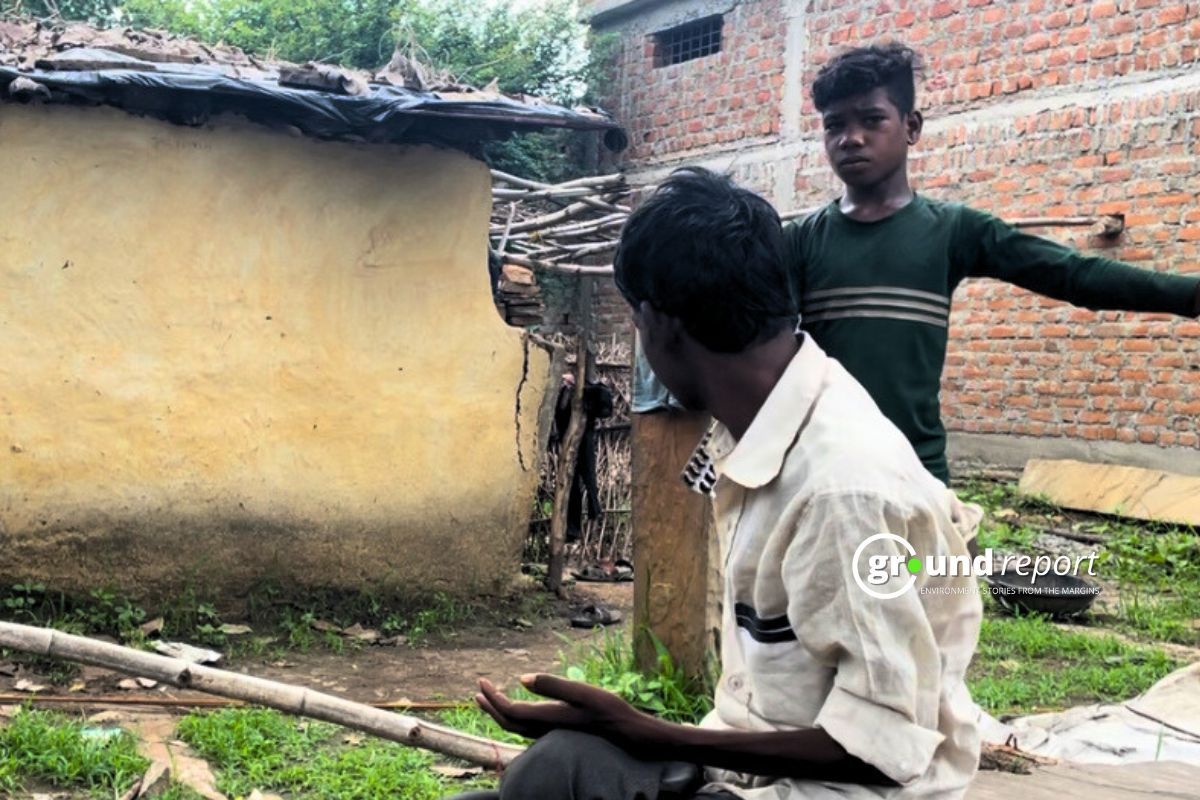Read in Hindi | Gendalal’s 12-member family is reduced to two people because of TB. He battles TB in his one-room house, with no government support.
Village Abupur Kucholi Block Ganj Basoda, District Vidisha, Madhya Pradesh, 38-year-old tribal Gendalal lives here with his 12-year-old son in a 6/6 feet kutcha house of one room.
The house is no respite either. In the room cum house, the only source of air and light is the door. Apart from a stove and utensils for cooking, there are clothes and a bed to sleep on. Life has not come easy to Gendalal, as he suffers from TB (Tuberculosis), and his body has become weak without care and proper food.

His neighbours tell us that Gendalal’s family once had twelve members. His father was the first to get TB and then the rest of the family. All of them slowly succumbed to this deadly disease. Now, Gendalal survives with his only son, as his primary caregiver. Gendalal says,
“Due to illness, I am not able to go to work now, my son runs the house. He goes to graze other people’s cattle and gets one sack of grain in a month.”

One of the main reasons for deaths due to TB is the lack of an adequate nutritional diet. Here, Gendala, and his two people’s family, rely on the 5 kg government ration and the single sack of grain his son earns. Green vegetables are a rarity in Gendalal’s diet. He mostly has dal and roti, he explains to us. When we asked him government’s free nutritional support to all TB patients, through Nishchay Mitras? He solemnly answered: NO!
Pramod Pateria, a local NGO worker, says,
“Here you will find patients in every house… many families have been destroyed. But the government and administration do not even come here to take a look. People here neither have employment nor food to eat, in such a situation how will they fight TB?”
Nutritional diet, and Nikshay Poshan

A nutritional diet is a necessity, in the first 6 months, along with timely diagnosis and treatment to defeat TB. A study conducted by the Indian Council of Medical Research ICMR also highlights the importance of nutrition in the prevention of TB. However, poverty and malnutrition in India weaken the country’s fight against the spread of this disease.
But, patients like Gendalal can barely manage two meals a day, let alone buy milk worth Rs 50 per litre. Gendalal says,
“Sometimes people from some social organization disturb fruits or laddus, but this happens only once or twice a month.”

The Government of India launched the Nikshay Poshan Yojana in April 2018, to help the patient with a nutritional diet during treatment. Under this scheme, all TB patients who are registered or notified (public/private) on the Nikshay portal on or after 1 April 2018 are given Rs 1500 as the first instalment and the second instalment of Rs 1500 after completion of 84 days from the date of start of treatment through DBT (Direct Bank Transfer). After this, Rs 500 is deposited in the patient’s account every month till the treatment is over.
According to the India TB Report 2023, 33 per cent of the patients could not receive this instalment through DBTs. Reports mention several obstacles from both sides–health providers and patients– like unavailability of bank accounts and/or no account linkage to Aadhaar, PAN-card etc. Apart from this, lack of clear communication, illiteracy and the multi-stage approval process are major obstacles.
No Nikshay Mitra was made for Gendalal

Another scheme, Nikshay Mitra Yojana, started on 19 September 2022 to ensure community participation in fighting TB. In this, any citizen, public representative, political party, non-governmental institution, or corporate institution can adopt a TB patient and pledge to arrange for their food. Under this campaign, a person or institution can adopt any TB patient or more than one patient from a village, ward, block or district for at least 6 months or more. Furthermore, ensure their basic amenities like food, nutrition or livelihood.
The information from the Nikshay portal shows that in Vidisha district, shows some interesting trends. Between January 1, 2024, to July 2024, while the notified number of government and private TB patients was 1622, only 357 Nikshay Mitras were registered. At the same time, there are 249 notified patients in Ganjbasoda, a block where Gendalal lives, against only 86 Nikshay Mitras registrations. Important to note, that the registration of a Nikshay Mitras doesn’t guarantee that a TB patient(s) is adopted.
Pramod Pateria, an employee of the social service organization Prasun in Vidisha district, reports that residents of Kuchola village do not benefit from schemes like Nishchay Mitras. According to him, these initiatives have failed to reach communities.
TB-free by 2025?
The GoI has set a target to become TB-free by the year 2025. According to the Nishchay portal, the total number of notified patients from January to July 28th, 2024, is close to 15 lakh. Last year, 24.2 lakh TB cases were reported in India, of which 3.2 lakh patients died. According to WHO, India’s contribution to global TB cases is 27% and in total deaths, the percentage is 35%.
This article is written under the Reach Media Fellowship 2024.
Follow Ground Report on X, Instagram and Facebook for environmental and underreported stories from the margins. Give us feedback on our email id greport2018@gmail.com.
Don’t forget to Subscribe to our weekly newsletter, Join our community on WhatsApp, and Follow our Youtube Channel for video stories.
Keep Reading
Fighting TB: ASHAs seek stability, better pay and health insurance
Lack of medicines malnutrition & poverty, will India be TB free?









